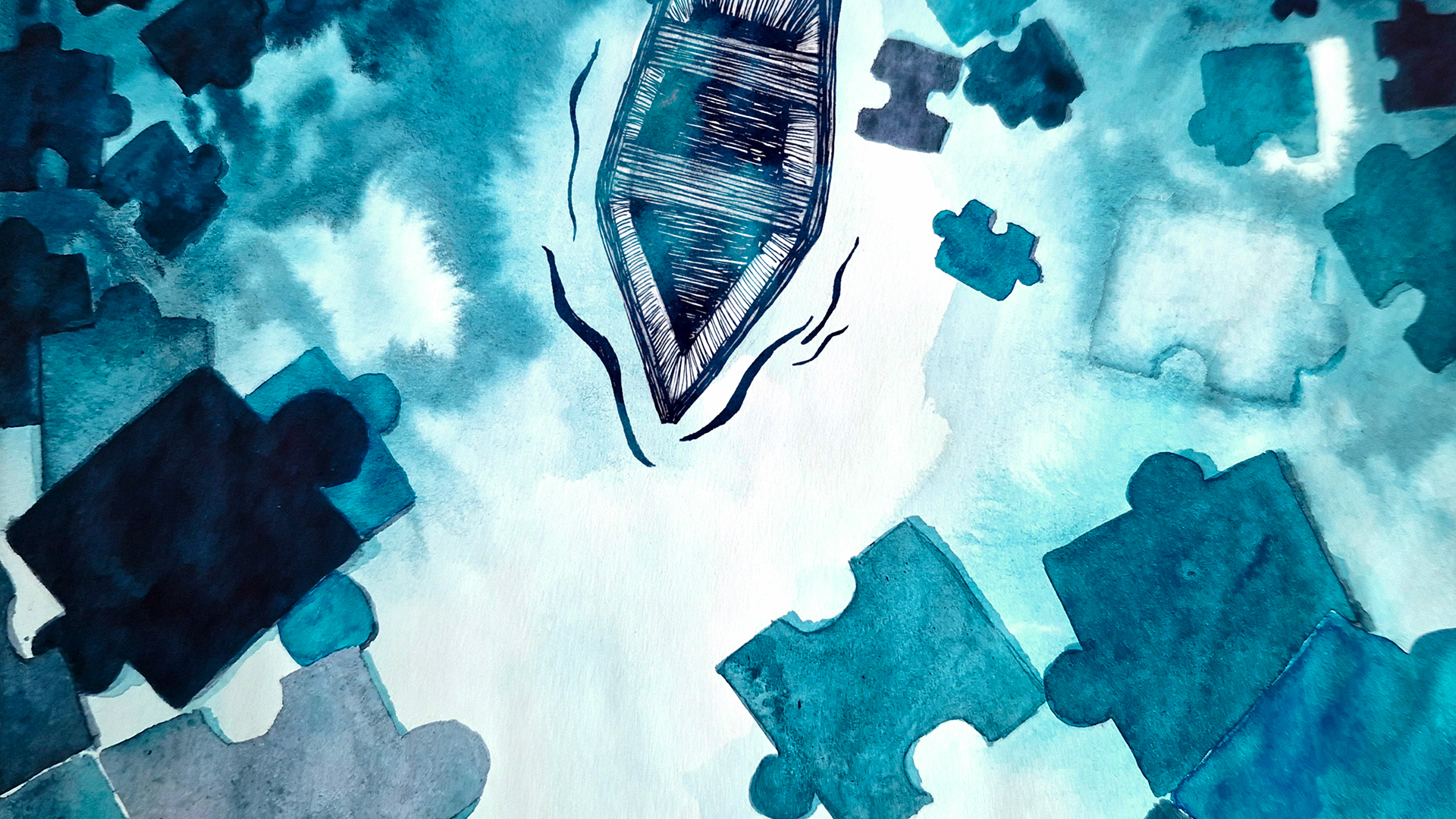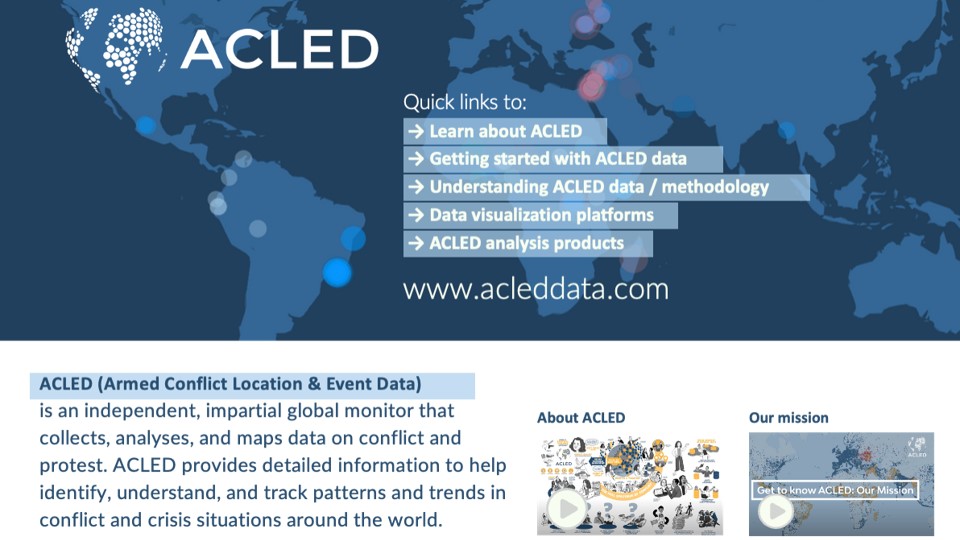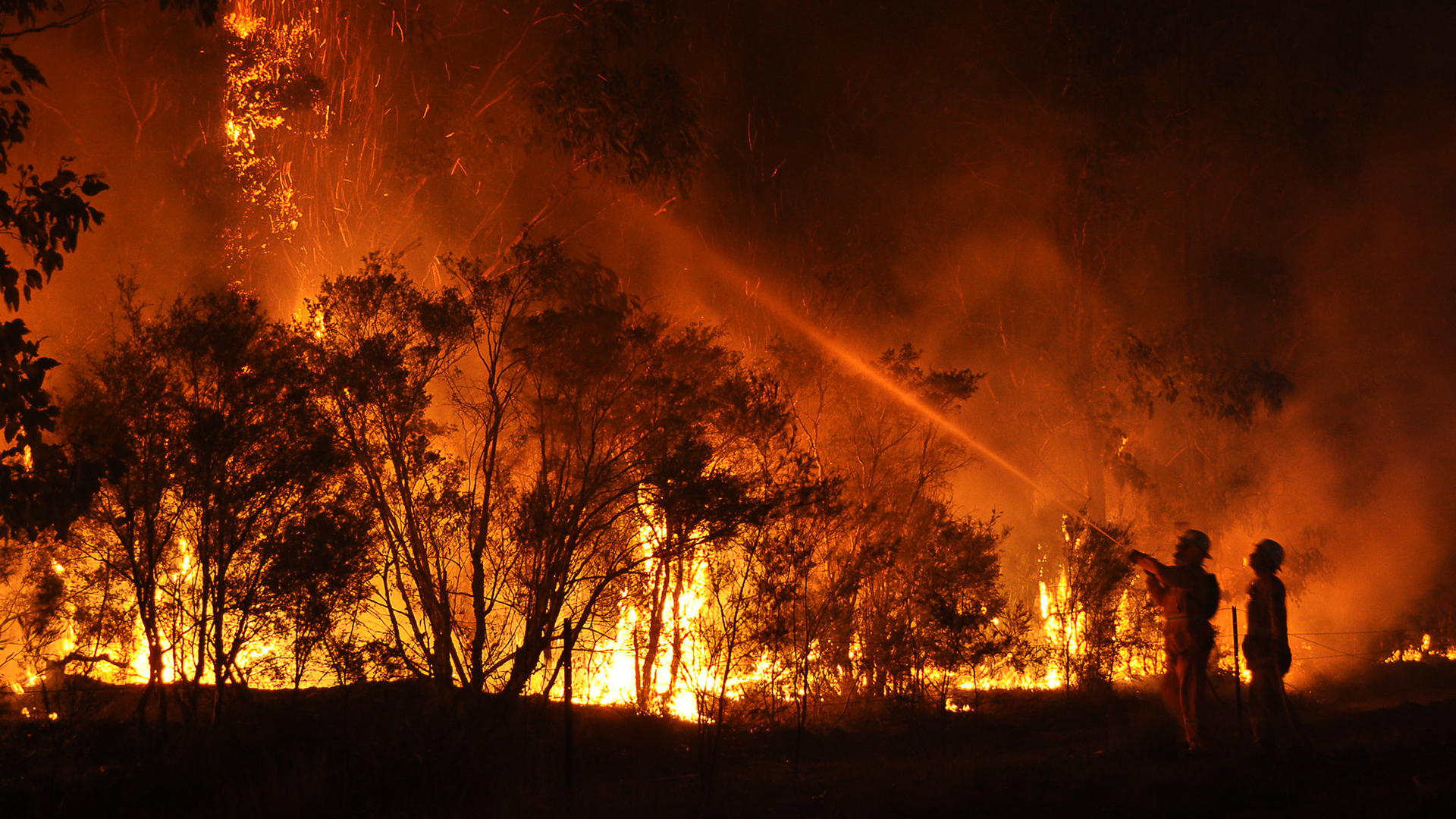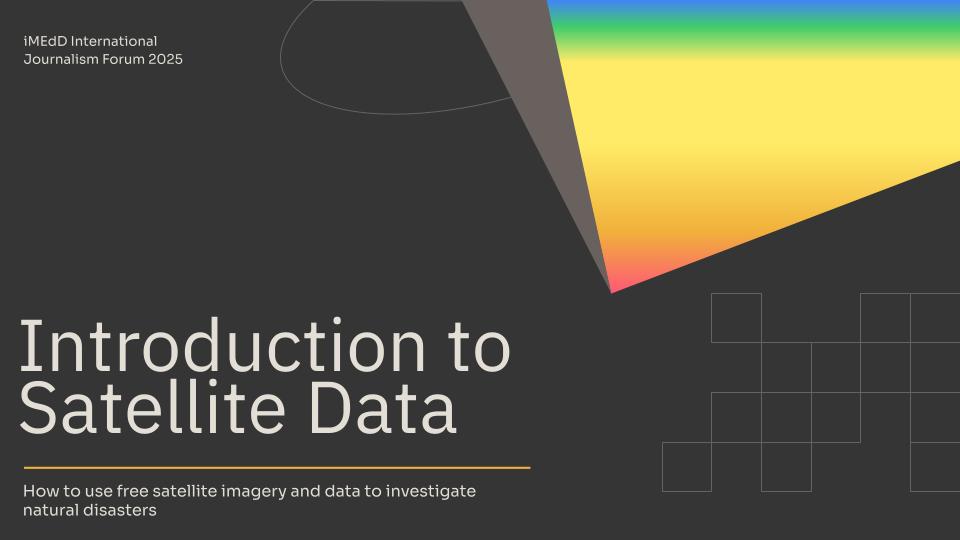From tracking online disinformation to using drones for sharper storytelling, these tipsheets from this year’s Forum workshops introduce a fresh set of tools and practices to make your investigations more impactful, accurate, and innovative.
This article is the first of our two-part series on the iMEdD International Journalism Forum 2025 workshops. You can revisit Part ΙI here.
- Investigative journalism masterclass
- Baby lions, birds and bullets – Investigating wildlife crime
- How to work with ACLED’s conflict data
- Audio diaries about (and with) youth
- Investigating extreme heat
- Investigating natural disasters with satellite imagery and data
- Using drones and sensors to power your reporting
- How to investigate online disinformation
- Coping with trauma and burnout on the job
Investigative journalism masterclass
by Emilia Díaz-Struck and Foeke Postma
Emilia Díaz-Struck, Executive Director of Global Investigative Journalism Network (GIJN) and Foeke Postma, Senior Investigator & Trainer at Bellingcat, focused on the introductory principles of investigative journalism, including its definition, methodologies, and techniques, no matter the medium and presented advanced internet research techniques for journalists.
Click on the image to find the full GIJN guide.

The following advice was provided during the workshop by Foeke Postma on methods for finding and verifying public information using open-source intelligence (OSINT).
- Open Source Research Accessibility: Investigations can be based on online information accessible to anyone with an internet connection. Common open sources include geospatial (like satellite imagery and maps), established media, user-generated content, and databases/archived materials. Some open source materials, such as leaked materials, contact books, app data, and the dark web, fall into a grey area regarding ethical and legal use.
- Look and listen closer: Pictures speak more than a thousand words. The smallest details can give away a location, form a connection, or become a lead for new findings. The shape of a rock, the stripes of a tiger, a small sticker, a shadow or reflection in a window, and even the sounds you hear in a video, can all be clues that can reveal crucial information.
- Data Footprints: Every data leak can reveal significant personal information that can be used for further research. Individuals leave both intentional (and sometimes forgotten) and unintentional (and never realized) traces online. The people around them are also likely to leave traces about your person of interest.
- Empathy in Research: Putting yourself in the shoes of the subject and considering their language, online spaces, and real-life hangouts can help in finding the right data sources.
- Real-world Applications of OSINT: When applied this way, open‑source research can reveal critical insights: it can pinpoint the locations and security parameters of U.S. nuclear assets stationed in Europe, track the activities of military personnel and intelligence operatives, and expose extremist networks, criminal enterprises, and pressing environmental issues.
- AI in Research and Geolocation: AI is useful for interrogating documents, large image sets, and interpreting slang, but it carries a huge risk of hallucination for geolocation and is not yet reliable.
- Benefits of Open-Source Research: Social media and the internet provide unprecedented access to information, data to explore, tools to use, and community participation, which can help establish truth. Bellingcat offers a guide on the many tools available that can help speed up open source research, as well as develop and publish its own for anyone to use.
Baby lions, birds and bullets – A live journalism workshop on wildlife crime
by Ingrid Gercama, Geri Emiri and Vanja Stokić
Journalists Ingrid Gercama, investigative reporter with the Organized Crime and Corruption Reporting Project (OCCRP), Geri Emiri, Executive Director of Amfora.al, and Vanja Stokić, Editor-in-Chief of eTrafika.net, showcased two cross-border investigations. One focused on the trafficking of baby lions through Albania and Kosovo, where exotic pets have become status symbols for both gangsters and businessmen. The other uncovered illegal quail hunting in Bosnia-Herzegovina, with reporters conducting nighttime fieldwork to expose a clandestine network involving Italian hunters. The workshop offered a rare opportunity to witness how investigative journalism can expose international environmental crimes.
On live journalism
Live journalism transforms journalistic content into immersive live performance by combining traditional storytelling with elements aimed at audience engagement. Live journalism hopes to:
- Builds trust and transparency. By bringing the reporting process of (investigative) reporting to the public, live journalism shows the work behind the story, fostering a direct connection and accountability with the audience and the journalists reporting on a story.
- Creates community and conversation. These types of live journalism events invite and gather people to engage directly with journalists and experts, turning a story into a shared experience and (hopefully) sparking a platform for meaningful dialogue.
- Revitalizes storytelling. Live journalism combines the factual integrity of reporting with the dynamic elements of a live-stage stage performance, by doing so offering a fresh, engaging way for audiences to consume news and journalistic investigations.
5 top tips for a live journalism session
- Preparation is key. Create a plan for your event, including a script, timings, and a checklist of essential equipment – from stage props, decor, microphones, speakers to extra power banks. A solid plan gives you a framework to be creative and flexible.
- Engage and entertain. The whole purpose of a live session is to engage your audience. Would you enjoy “another” boring conference session? No, right? So don’t be afraid to think outside of the box and make it fun. Be human, authentic, and use humor.
- Be adaptable. The audience’s engagement is a key factor you can’t control. Be ready to adjust your approach on the fly. This means thinking on your feet, being flexible, and being prepared to pivot quickly and with transparency and a good dose of humor.
- Maintain ethical standards. While you’re in a dynamic format, don’t forget your journalism ethics. Always present facts accurately, avoid personal bias, and correct any errors quickly and transparently. Your credibility is your most important asset.
- Listen and Learn. A live session is a conversation, not a lecture. Pay close attention to audience reactions, both verbal and non-verbal. Use their feedback to steer the conversation, answer questions, and make the experience meaningful for everyone.
How can you share back with the community you work in?
One powerful way to give back to the community you reported in is by sharing your work directly with them. For example, when online media outlet eTrafika investigated illegal quail poaching by Italian hunters in Bosnia and Herzegovina, they did more than just publish their findings. They held in-person screenings of a short film they produced, with support of Journalismfund Europe, in the communities they conducted their investigation on.
These events sparked conversations, brought together diverse groups — like local citizens, police inspectors, journalists, and even hunters — and created a space for dialogue. The screenings hence, not only shared information but also built trust and empowered the community to take action, turning a report into a real-world catalyst for change.
On covering wildlife crime stories
Wildlife crime refers to a range of illegal activities that harm wild animals, plants, and their habitats. It is a serious and widespread form of (often transnational) organized crime, often linked to other illicit activities like drug trafficking and money laundering.
Types of wildlife crime include:
- Poaching – the illegal hunting, killing, or capturing of wild animals.
- Illegal trafficking – the smuggling and trade of live animals, or their parts and products (e.g., ivory, rhino horn, pangolin scales, exotic animals illegally caught from the wild).
- Habitat destruction – the unauthorized damage or destruction of areas crucial for wildlife, such as illegal logging or land clearing of rainforests or pollution of seas and oceans.
- Illegal fishing – harvesting of fish in violation of local/national/international laws.
- Illegal pet trade – the illegal capture and sale of wild animals for the pet market.
Wildlife crime reporters write about the illegal activities that harm wildlife and their ecosystems, such as poaching, illegal trafficking of animal (parts), and habitat destruction. This type of journalism exposes the often transnational, criminal networks behind these crimes.
5 top tips for a wildlife crime reporters
- Follow the money and the paper trail. Don’t just report on the poacher. Investigate the entire supply chain, from the hunter to the smuggler to the consumer. Examine court records, seizure data, and financial transactions to uncover the bigger picture.
- Widen your lens. Move beyond the “charismatic megafauna” like elephants and rhinos. The illegal trade affects thousands of species, including reptiles, birds, plants, and timber. Highlight lesser-known species to show the breadth of the crisis.
- Cultivate sources. The most valuable information often comes from people working in the ecosystems you want to report on: park rangers, conservationists, indigenous communities, traders, and even former poachers. They have firsthand knowledge of the threats and provide critical insights that official sources may lack or don’t want to share.
- Prioritize safety. Reporting on criminal syndicates can be dangerous. Take precautions, be discreet, and never put yourself or your sources in any unnecessary danger.
- Connect it to a broader story. Frame the issue not just as a crime against nature but as a crime against society. Link it to issues like corruption, rule of law, and economic development to demonstrate why it should matter to a wider audience, including policymakers and citizens who might not see themselves as conservationists.
Tips from an investigation into the latest fad of organized crime in Albania – baby lions
In Albania, a team of journalists from Albania, Kosovo, Germany, the Netherlands uncovered how organised crime figures were acquiring exotic pets — baby lions — as symbols of wealth and power, flaunting them on social media. Because criminals rarely register such property in their own names, establishing ownership was a challenge. The journalists devised an innovative method: they monitored online posts, matched visual details with geographic markers, cross-referenced information from multiple sources, and then visited the identified locations to verify the findings on the ground. The investigation revealed not only the growing appetite of organised crime groups for such illicit pets, but also the risks faced by those who expose them.
Read more about the investigation here.
Safety – tips from an investigation into illicit quail hunting in Bosnia-Herzegovina
When investigating dangerous topics, eTrafika, an online media outlet in Bosnia-Herzegovina, developed a safety system. Before their investigation into illegal hunting, they created a separate group chat for team members not involved in the reporting. Here’s how they did it:
- Share your details. They provided the names, photos, and contact information of the journalists, along with the addresses and phone numbers of their accommodations.
- Check in regularly. They shared their exact location with the group every hour while in the field. When situations became more intense or locations changed frequently, they checked in even more often.This system ensures that if something goes wrong, a team outside of the investigation knows exactly where to look.
This system can be done in multiple ways, but remember safety before everything else.
Read more about the investigation here.
What are conflict data and how can journalists use them in reporting
by Dr. Katayoun Kishi and Ana Marco
ACLED’s Head of Data Science, Dr Katayoun Kishi, broke down how ACLED collects and verifies conflict data and explained why you can trust the data for journalistic reporting. Participants had the opportunity to gain hands-on experience exploring ACLED data using a suite of platforms designed to provide fast, intuitive, and actionable insights for reporting and analysis. Ana Marco, ACLED’s Research Analyst also shared best practices for interpreting the data, helping journalists integrate these findings into their reporting to strengthen analysis and enhance credibility.
Click on the image to find the full ACLED presentation.

Telling stories about (and with) youth: Radio Workshop’s audio diaries
by Nonhlanhla Mashabana, Lesedi Mogoatlhe and Dhashen Moodley

In this workshop, participants explored creative and ethical approaches to collaborating with young people in order to tell authentic, narrative-driven stories for the Radio Workshop podcast. Using the two-part series Finding the Right Words as a case study, Radio Workshop’s Editorial Director, Lesedi Mogoatlhe, and Senior Producer, Dhashen Moodley, unpacked the storytelling process behind the portrait of Nonhlanhla Mashabana—a South African spelling bee champion who documented her final year of high school through audio diaries, capturing both the hopes and challenges of her transition to university. This method turns the subject of the story into the storyteller, allowing them to share insights as the narrative unfolds. The first episode of the series went on to be named a finalist at the New York Festivals Radio Awards.
Why use audio diaries?
- If you get someone to record themselves, it’s perhaps a more authentic take on their life, more real, and less filtered.
- Audio diaries can help the character express themselves. The diaries become a place where the diarist can be vulnerable.
Advice from Nonhlanhla
- Keep the tape rolling. Whatever you do, just don’t stop and then press again. Just when you are planning to record, just let it be talk, talk, talk.
- If there’s someone out there who is about to document a moment in their lives like I did, one thing I would say to them is be yourself. Nothing beats being yourself. Be kind to yourself as well.
- Do not pressurise yourself. That way, you get to learn about who you are without having conflict with your thoughts.
- It’s okay to be vulnerable. It’s okay to cry. That’s something I learned when I was still recording. It’s okay to let us hear your miserable moments. It’s okay to pour your heart out. It’s okay to be uncertain. And it’s okay to not have anything to say.
Investigating extreme heat
by Nicolia Apostolou and Laurie Goering
Nikolia Apostolou, Resource Center Director of Global Investigative Journalism Network (GIJN) and Laurie Goering, Climate Change Journalist & Extreme Heat Editor for Climate Resilience for All presented key areas to investigate, including medical consequences, the impact on vulnerable populations, economic and agricultural effects, impacts on sports and culture, infrastructure challenges with increasing demand for power and water and gender differences in heat vulnerability. The workshop was curated by GIJN.
Click on the image to find the GIJN Guide to Investigating Extreme Heat, republished on iMEdD Content

How to use free satellite imagery and data to investigate natural disasters
by Laura Kurtzberg and Konstantina Maltepioti
Laura Kurtzberg, Training Director of Investigative Reporters & Editors (IRE), and Konstantina Maltepioti, Data Journalist, Reporters United/Mediterranean Institute for Investigative Reporting (MIIR), presented an introduction on how to work with satellite data. They introduced participants to the methodology developed by the Troubled Waters project, organised and coordinated by MIIR, with the collaboration of the European Data Journalism Network, to retrieve, clean, and structure Copernicus flood data from 2023 to 2024.
Click here to access the full workshop tipsheet, which includes tools and resources for conducting investigations with satellite imagery.
Click on the image to find the full workshop presentation.

Using drones and sensors to power your reporting
by Justin Arenstein, Johnny Miller and Alicia Olago
Justin Arenstein, Founder & Chief Strategist at Code for Africa (CfA) and Co-CEO of ICFJ+, together with photographer Johnny Miller and Alicia Olago, Senior Product Manager at CfA, demonstrated how frontline media can use cost-effective drones, sensors, and satellite imagery to collect field data that fuels impactful journalism. The workshop was hosted by Code for Africa—the continent’s largest civic technology network—and ICFJ+, a new organization created by CfA, the International Center for Journalists (ICFJ), and systems builder PROTO to strengthen news and information ecosystems worldwide. In addition to learning how to integrate sensor and drone data into investigative storytelling, participants explored real-world examples from across Africa, where CfA has supported journalists in exposing pollution, informing public policy, and powering legal action through its sensors.AFRICA and africanDRONE initiatives.
You can find the Code of Africa Factsheet here and their GitHub here.
Click on the image to find the full Code of Africa presentation.

How to investigate online disinformation (and who is behind it)
by Jose Luis Peñarredonda and María Teresa Ronderos
José Luis Peñarredonda, Editor at the Latin American Center for Investigative Journalism (CLIP), and María Teresa Ronderos, CLIP’s Director, led a workshop for participants seeking to understand how influence operations unfold online. The workshop demonstrated methods for analysing web infrastructure and social media activity, and examined the broader connections between disinformation and political interests, showing how these dynamics shape key moments such as elections and referendums.
Find leads of possible disinformation operations. Where to find them?
- Fact-checking outlets
- Social media
- Ad campaigns
- Human sources
Once you settle down on a lead, find other content examples. How to do it?
- Look for bits of content that are likely to repeat on different pieces, like names, texts, hashtags, URLs, or images.
- If you have access to social listening tools, use them:
- Meltwater, Brandwatch ($$$$)
You can also resort to dedicated search tools too:
- TikTok: internal search, Google search [query] site:tiktok.com
- YouTube: Filmot
- X: internal search
- Facebook, Instagram: Meta Ad Library
Looking for people
More than names, your main targets at this point are emails, phones or domains. Look for them in:
- Once you have emails or phone numbers, you can look for them in Osint.industries or IntelX
- Once you have web domains, you can find them on any Whois search engine, such as Whoxy.
- Bios in platform accounts
- Handles in Osint.industries
- Transparency reports from ads
You should end up with people’s and/or companies’ information: Names, IDs, addresses, emails, etc.
Looking for companies
Search for companies’ information in:
- Global databases
- Business registers by region
- Sites of companies, “investors” tab; privacy policy could reveal real owner; imprints in webpages give names and addresses
- Financial reports by country
Good places to start
- EDGAR (US)
- SEDAR+ (Canada)
- Companies House (UK)
- CLIP’s NINA (commercial and public procurement info in Latin America)
Investigating distribution
Investigating distribution is a key technique for understanding who are the most active and the most powerful distributors of disinformation. Also, it can be useful to find related digital properties you could have missed earlier.
- For a quick glance, you can use quick searches from social listening software
- For related web properties, you can use a tool called Built With, tab Relationships
- For a detailed investigation, you can use relational databases and graphs using tools such as Gephi or Kumu
What to look for at narratives?
- How are actors portrayed? Who is being shown in a good or bad light?
- Do they mirror official, government, or foreign actor narratives?
- Are narratives repeated across different countries or contexts? E.g., “elections were stolen”, “the military were unfairly treated”, etc.
- What interests are they finally pushing?
Why Collaboration is the Way Forward
- Disinformation consultants always copy one another. To compare if patterns are – in different countries will help you unearth those behind it.
- Many actors disinforming are cross-borders: human traffickers, rogue companies, extremist parties…
- You learn, you grow, you ask questions about your own country that you would never have asked before.
- The world shrinks, you look for companies/people in three countries, you verify one in another.
- Collaboration is also with non-journalists. Digital rights experts may know a lot of techniques.
- We have been able to do stories where journalists were protected by a collective signature so that they can tell stories with less risk.
- Unveiling disinformation must be ubiquitous, just like disinformation is.
Coping with stress, trauma and burnout on the job
by Dr. Katherine Porterfield

Dr. Katherine Porterfield, Founding Staff Member of the Global Center for Journalism and Trauma, gave practical advice on coping with stress, trauma, and burnout in turbulent times. Her workshop covered basic awareness of the impact of direct trauma exposure, vicarious trauma exposure, moral injury and related stresses on individual journalists and news teams, and offered evidence-based practices for enriching one’s coping skills and building resiliency.
These tips were shared during the workshop and compiled into a practical tipsheet.
- Journalism, news and media professionals work in a field that can be trauma-facing in terms of stories we cover, communities we engage with and people who we interview, film, record and photograph.
- Journalism can involve a secondary impact of trauma, as professionals engage with narratives, photographs, data, audio, and video content that involves human suffering, harm done to others, natural disasters and other disturbing events.
- Stress and trauma are not the same thing.
Stress can involve normal experiences that require us to adapt—deadlines, financial concerns, health issues, family and relationship concerns.
Trauma involves an event or events that creates a bodily survival response, usually of fight/flight or in some cases shut down/disconnection. These responses are involuntary and are designed to protect us when we are under threat.
- Burn-out refers to a response to one’s occupation and not necessarily to whether the work entails trauma or not. Burnout has been defined as:
– Feeling depleted or exhausted in relation to one’s work
– Feeling less effective in one’s work
– Feeling negative about one’s work
- Stress and trauma and affect humans in biopsychosocial ways. Noticing how you might be carrying stress or trauma reactions is critical to then adding biopsychosocial wellbeing practices. This means noticing:
– BIO: The physical ways that we respond to stress or trauma and what resilience practices we can put into place for our bodies.
– PSYCHO: The meaning-making we engage in regarding our stories, communities and our roles as journalists. This means noticing our thoughts and feelings around what we do.
– SOCIAL: The social responses we have to trauma and stress in terms of connecting to others vs. isolating or turning away.
6. Building a well-being practice entails intentional and regular attention being paid to ourselves and our teams
- Burnout can be best addressed organizationally through:
– Communication opportunities within and among staff and management
– Acknowledgement to staff that the work can be challenging
– Enhanced agency/autonomy for staff in their work
– Clarity around roles and tasks for staff
- Building a biopsychosocial wellbeing practice takes time and practice:
– Add body-based tools that allow you to rest and restore yourself
– Some examples: yoga, mindfulness, breathing techniques, moving your body, getting outside in nature during the day
– Engage your meaning-making by processing and talking with others about your work and noticing how you think about the work
– Create social opportunities for pleasure, connection and mutual support
